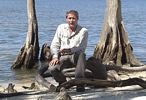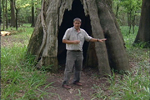Southeastern Channel special spotlights bald cypress
Contact: Christina Chapple
10/12/06
(1)
 (2)
(2) 
CAPTIONS …
(1) NATIVE CYPRESS -- Charles Reith, host of the Southeastern Channel’s “Backyard Wonders,” sits on a distressed cypress root along the shore of Lake Pontchartrain at Fontainebleau State Park in Mandeville discussing the condition of bald cypress trees on the north shore in an upcoming episode of "Backyard Wonders," a show about native plant and animal life on the north shore. The new episode exploring the nature and importance of cypress species will first air at Oct. 18 at 8 p.m. on the Southeastern Channel, Southeastern Louisiana University's educational cable access channel on Charter Cable Channel 18.
(2) LARGE CYPRESS -- Show host Charles Reith points out some of the world's largest bald cypress trees at the Cat Island National Wildlife Refuge in St. Francisville and discusses their natural habitat and place in the southeast Louisiana ecosystem in an upcoming episode of "Backyard Wonders," a show about native plant and animal life in the Florida Parishes. The new episode exploring the nature and importance of cypress species will air Oct. 18 at 8 p.m.on the Southeastern Channel, Southeastern Louisiana University's educational cable access channel on Charter Cable Channel 18.
HAMMOND -- Despite the battering that Louisiana’s natural forests took from Hurricane Katrina, one tree that stood tall through it all was Louisiana’s state tree, the bald cypress.
From its durability, beauty and utilitarian purposes to its ecological importance, the cypress species of south Louisiana is examined in a new episode of “Backyard Wonders,” first airing Oct. 18 at 8 p.m. on the Southeastern Channel, Southeastern Louisiana University’s educational cable access channel. “Backyard Wonders” spotlights native plant and animal life in the Florida Parishes.
The 30-minute special follows host Charles Reith on journeys to national and state parks, swamps, wildlife refuges and even north shore residences to explore the nature of the bald cypress and how it fits into the region’s ecosystem and horticultural landscape.
“'Backyard Wonders’ is a series that creates appreciation for indigenous natural wonders located right here on the north shore -- in your own backyard, so to speak,” said Rick Settoon, general manager of the Southeastern Channel and the show’s executive producer. “The show also informs viewers about preserving the natural environment and ecosystem, beginning in their own backyards.”
“This episode helps viewers appreciate what a precious natural resource we have in cypress trees, from their purposes in natural habitat to uses in furniture-making, home-building and landscape development,” Settoon said.
The program was produced, videotaped and edited by Southeastern Channel staff member Josh Kapusinski.
“We went to great lengths and many locations to illustrate how beautiful and viable a healthy cypress ecosystem can be to the entire state of Louisiana, both economically and ecologically,” Kapusinski said. “It’s important for people to know this story and learn how much impact cypress has and can have in forests, along the coastline, for habitat and in backyards protecting homes.”
Reith, who has lectured on environmental management at Southeastern and other universities, travels to Fontainebleau State Park in Mandeville to observe the condition of distressed cypress groves and how the bald cypress withstood recent hurricanes.
He discusses the virtues of working with cypress wood with furniture maker Terry Wilde of Ponchatoula and cypress craftsman Paul Laplace of New Orleans, who builds durable homes from old cypress.
The host visits the Jean Lafitte National Historical Park in Marrero to examine a healthy cypress forest and its attributes before moving to the Cat Island National Wildlife Refuge in St. Francisville to look at the largest cypress tree in the world and the forest’s overall depletion caused by the logging industry.
Reith then travels to a cypress restoration project site at Lake Maurepas to interview Southeastern biology professor Gary Shaffer about his federally-funded project to restore the wetlands involving cypress.
Finally, Reith shows how cypress can help one’s backyard landscape when he tours the Folsom residence of Jonathan Riley.
“The production element of the show was challenging due to the nature of the locations,” Kapusinski said. “There were mile-long stretches down nature trails carrying equipment and maneuvering through knee-deep swamp water wearing waiters to shoot interviews in 90-plus degree temperatures.”
The Southeastern Channel, which has won more than 40 national television awards in the past three years, can be seen on Charter Cable Channel 18 in Tangipahoa, St. Tammany and Livingston parishes and on Channel 17 in Washington Parish. It can also be viewed on the Internet at www.selu.edu/tv.
More News...
